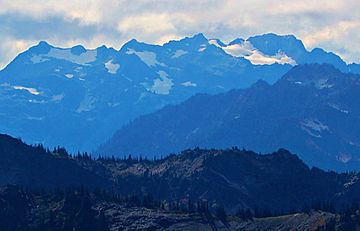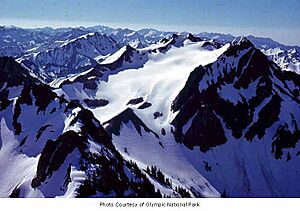Mount Christie (Washington) facts for kids
Quick facts for kids Mount Christie |
|
|---|---|

Mount Christie
|
|
| Highest point | |
| Elevation | 6,181 ft (1,884 m) NAVD 88 |
| Prominence | 1,777 ft (542 m) |
| Geography | |
| Location | Jefferson County, Washington, U.S. |
| Parent range | Olympic Mountains |
| Topo map | USGS Mount Christie |
Mount Christie is a tall mountain peak. It is found in the Olympic Mountains in Washington State, U.S.A. This amazing mountain is part of the Olympic National Park.
Mount Christie is located in a special area called the Queets-Quinault group. Water from rain and snow on the mountain flows into two different rivers. On the north side, it drains into the Elwha River. On the south side, the water flows into the Quinault River.
This mountain was named after a brave explorer, James Halbold Christie. He led a group called the Seattle Press Expedition. This group was the first to explore the unknown parts of the Olympic Mountains. They did this between 1889 and 1890. Mount Christie is actually a large mountain mass with several peaks. It also has a big glacier called the Christie Glacier. This glacier sits in a bowl-shaped valley (a cirque) on the north side, below the main peak.
Weather at Mount Christie
Mount Christie is in a special weather area called the marine west coast climate zone. This type of climate is found in western North America. Most of the weather systems start over the Pacific Ocean. They then travel northeast towards the Olympic Mountains.
How Mountains Affect Weather
When these weather systems reach the Olympic Mountains, they are forced to rise. As the air goes higher, it cools down. This causes the moisture in the air to turn into rain or snow. This process is called Orographic lift. Because of this, the Olympic Mountains get a lot of rain and snow. This is especially true during the winter months.
Seasonal Weather Patterns
In winter, the weather is usually cloudy. But in summer, high-pressure systems form over the Pacific Ocean. These systems often bring clear skies. So, there is usually little or no cloud cover during the summer. Because of the ocean's influence, the snow on Mount Christie is often wet and heavy. This kind of snow can create a danger of avalanches.


